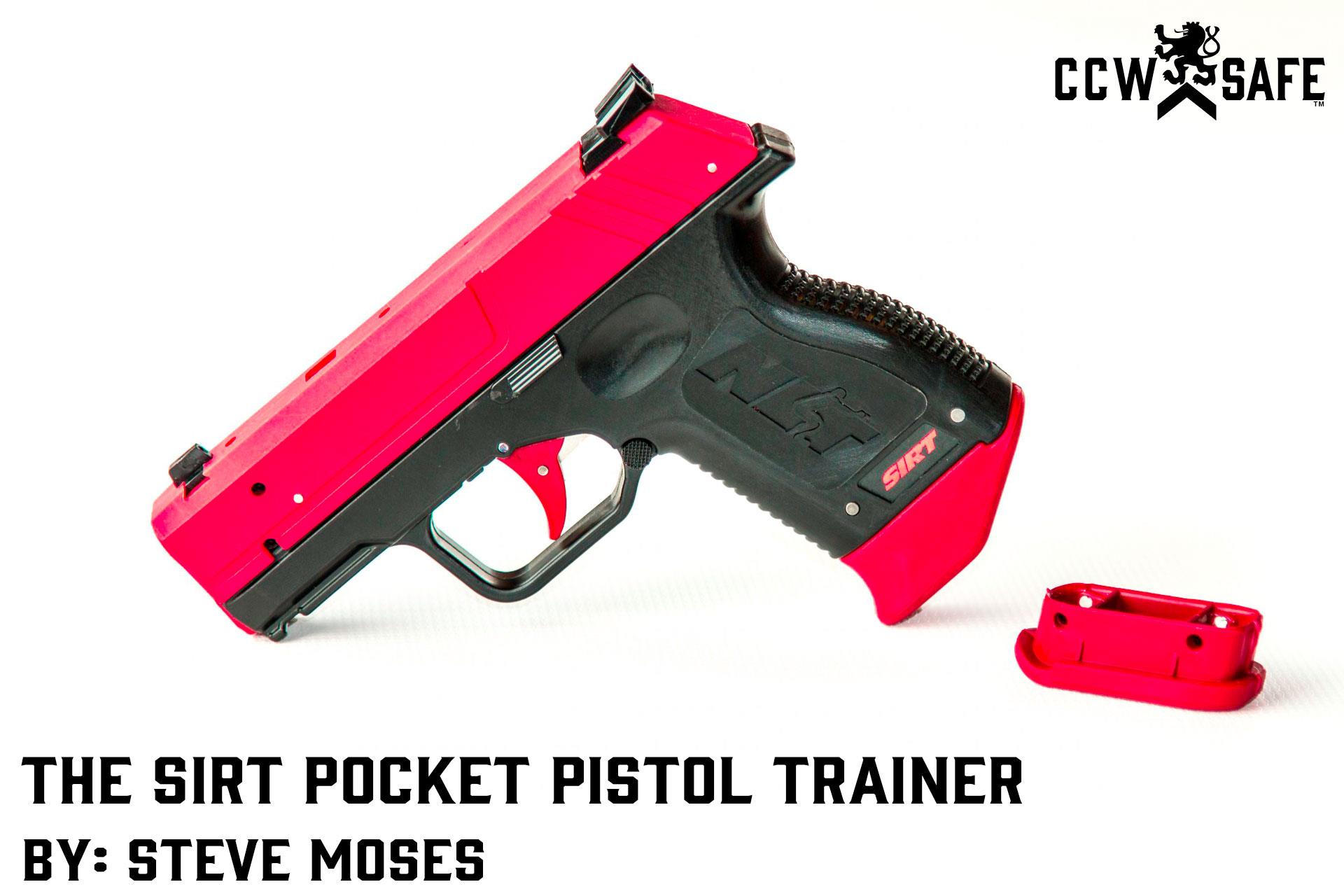
Posted on March 7, 2022
THE SIRT POCKET PISTOL TRAINER
While attending a Force-on-Force Instructor class taught by master firearms trainer Karl Rehn I was exposed to a dedicated laser training device called the SIRT Pocket Pistol. I was already familiar with the larger full-size versions of the SIRT pistol that had been around for years, and even owned one at one time. It possessed an auto-resetting adjustable trigger, one laser that was engaged by taking up slack on the trigger, and another laser that was engaged when pressed to the rear. Mine eventually wore out, and I never bothered to replace because I was not convinced at the time that the benefits of training with it offset its price. My rationale was that it did not really feel like the Glock 19 I carried and the trigger always felt different no matter how I much adjusted it. Regardless of my “trigger control” success with the SIRT pistol during dry-practice sessions the results never seemed to translate as well as I hoped during live-fire practice.
What makes the SIRT Pocket Pistol different? First, it is similar in size and configuration to an impressive variety of concealable sub-compact pistols like the Glock 42/43, Sig 365, and Smith and Wesson Shield. The sights can be changed out and it comes with several baseplates that can be swapped out in order to simulate the difference between the various models of sub-compact pistols. The reasons that I like this particular version are set out below:
- If I can work a five-pound trigger on a lightweight pistol and not move the sights off the target when pressing the trigger, it is even easier to do with a heavier pistol with the same trigger weight.
- I never carry a full-sized service pistol anymore. The largest pistol I will carry is a compact Glock 19, and I find myself carrying it less and less as time goes on. For me, the thinner Glock 48/43X pistols make more sense as they are easier to conceal, they shoot like larger pistols, and regardless as to what state I am going to travel to the ten-round magazine does not fall afoul of a restriction on magazine capacity.
- How I train now is different than how I trained years ago. I have a far better understanding of how to properly grip the pistol, manage recoil, and even work the trigger than I did before. I have found that I did not need to fixate nearly as much as I was before on perfectly pressing the trigger as long as the trigger was not overly heavy or contained noticeable creep. As long as I can hold the sights on target until the trigger press is complete and the bullet leaves the barrel I can expect to be greeted with success. In other words, I can accomplish the same thing with the smaller pistol that I can with the larger pistol. If that is the case, why not work on those skills with a pistol that is closer in size to the ones that I normally carry?
I primarily work from the Low Ready and High Ready positions when training with my Pocket Pistol. My goal is to quickly and smoothly extend my muzzle towards the target so that by the time I reach the desired extension my front sight is not dancing all over the desired impact area. Any attempt on my part to do this at high speed usually results in an action not unlike “slamming on the brakes” and an increased possibility of missing the target. There are some really good competitive shooters who are capable of moving at full speed most of the way and then smoothly slowing down right before their muzzle achieves full extension, but I am not one of them.
Most of my speed comes from a combination of economy and efficiency of motion. I want to get to get to my desired level of extension by taking the shortest possible route and along the way I want to visually pick up the front sight and place my index finger on the trigger and take up all of the slack. By the time that I have properly accomplished all of the above I can see the sight superimposed on the target, any wobbling of the front sight is insignificant, and all I need to do now is complete the press of the trigger and not move the muzzle. NOTE: All firearm safety rules are still in effect, which includes keeping the trigger finger outside the guard and off of the trigger until I am ready to fire. I comply with this rule during dry practice sessions with the SIRT Pocket Pistol as well as my concealed carry pistols by first placing my target on an impenetrable wall and second by waiting until at nearly full extension before placing my finger on the trigger. A bad habit to avoid is placing the finger on the trigger as soon as the handgun starts moving. A definite plus of the Pocket Pistol is that if I also use the one laser that is engaged by taking up slack on the trigger it will quickly let me know whether or not I am getting on the trigger too quickly.
Virtually every time that I have missed my target at the range was because the front sight or red dot was no longer on the target when I fired the shot. The majority of those misses took place because the front sight or red dot was literally in the act of moving when the bullet exited the barrel. The best way for me to ensure that this does not happen is to grip the pistol as hard as possible with maximum focus on pressure derived from the little finger and ring finger of both hands so that I am unable to clinch any harder while anticipating recoil and pressing the trigger. A small mental trick I play on myself is based upon my martial arts background that goes back to the mid-1970s. Japanese Jiu Jitsu instructor Ernie Gill was very spiritual and placed a great deal of importance on achieving harmony between the mind and body. I sometimes say or think say words such as “smooth” or “hold” when practicing certain actions. I find it easier to avoid being jerky on presentations to the target when thinking “smooth” and easier to keep the front sight or red dot on the desired target area while completing the trigger press when thinking “hold.”
Of course, what appears to hold true for me may not be the same for others. As of right now I am of the opinion that I can get a lot done at home by practicing with a SIRT Pocket Pistol while training myself to grip the pistol firmly and practicing presentations that focus on smoothness, trigger control, and not letting the sights move off the target when the trigger is pressed. While I am still seeing just enough of the front sight or red dot to confirm that I am properly aligned with the target my focus is not so hard that I am unable to see the laser dot impact upon the target when taking the shot. I also like the fact that the auto-resetting trigger resets itself upon release, which is not true when performing dry practice with an actual semi-automatic pistol. This simply means that I am also getting quality repetitions resetting the trigger and making preparation to fire a subsequent round that normally I can only achieve when shooting live ammunition.
In all candor, not all of my ideas about supplemental training devices have worked out. I definitely have no idea if what I said above about self-talk will hold true for others, but I am confident that proper practice with a SIRT Pocket Pistol (or full-sized version) can provide some instant feedback that normally is only available during live-fire practice at the range.
 |
Steve MosesSteve Moses has been a defensive firearms trainer for over 26 years and is a licensed Texas Personal Protection Officer with 7 years of experience performing as shift lead on a church security detail for a D/FW area metro-church. Steve is a co-owner and Director of Training for Palisade Training Group, LLC based in Dallas, Texas. Moses is a retired deputy constable and spent over 10 years on a multi-precinct Special Response Team. He owns multiple instructor certifications, including Rangemaster Advanced Handgun Instructor and Defensive Shotgun Instructor, Red Zone Knife Defense Instructor and Adaptive Striking Foundations Instructor, Modern Samurai Project Red Dot Sight Instructor, and State of Texas Personal Protection Officer Instructor. Steve holds a BJJ Brown Belt in Relson Gracie Jiu Jitsu. He is a content contributor for CCW Safe and writes weekly articles on various subjects of interest to concealed carriers. Moses shoots competitively and holds an IDPA Expert rating. Steve is an annual presenter at the Rangemaster Tactical Conference. |